Extras din proiect
ABSTRACT
The realization of an integrated tourist offer both cultural and historical is the main direction of the tourism development strategy for the Tomis Fortress and Constanța Municipality. The implementation of this strategy shows that during this process there will be a series of projects and visions for the development of archaeological tourism in Constanta Municipality. Through qualitative assessments of the main archaeological remains, through investigations of their relationship with the modern city of Constanta and the main problems that hold the development of the fortress, i suggest adjustments and proposals for development for the old Tomis Fortress.
KeyWords: tourism offer, archaeological tourism, tourism development, touristic valorisation, archaeological remains
Introduction
Historical tourism, included in the category of cultural tourism, is represented by the legacy of historical and archaeological artifacts that complement the classic offer of traditional tourism, consisting of outstanding attractions. Romania has several historical heritage sites dating back to the Greek and Roman era. Among them, an important place is the Tomis Fortress located in the city of Constanța. Tomis, today's Constanța, was founded more than 2,500 years ago by Greek seafarers and merchants from the town of Milet (Asia Minor), attracted by the shelter offered by the bay and peninsula formed on the Black Sea shore, as well as the very good exchange of products made with the chiefs of the local population (VULPE, 1966).
The modern city of Constanta, built on the ancient ruins of Tomis, is the capital of Constanța County, the largest city in the whole Dobruja and the South-East Development Region, being also the oldest inhabited city in Romania. It is an important municipality and a cultural, economic and social reference centre. Port city with a multitude of cultural traditions and historical heritage is currently an important cultural and economic center on the west coast of the Black Sea. More than 2,500 years of history testify to the rich cultural heritage of this corner of civilization, whose traces delight anyone.
Among the most notorious cultural and archaeological objectives that benefit from the attention and analysis of specialists are represented by archaeological remains, such as the remnants of the Roman wall defending the fortress of Tomis, the most precious architectural complex The Roman Mosaic Edifice, the Large Basilica and the Small Basilica (5th - 6th î.Hr. Roman-Byzantine era), Tomis city dwelling (4th century î.Hr - 5th century d.Hr. Greek, Roman, Roman-Byzantine era), Gumelnița culture, Apeductes - galleries, Roman Termes and specific cultural objectives : Armenian Church (1880), Genovez Lighthouse (1861), House with Lions (1902), Casino (1910), Elpis Theatre (1910), Greek Church Metamorphosis (1867), National History and Archaeology Museum (1913-1921), Hunchiar Glass (1862), Royal Residence (1908-1912), Museum of Folk Art (1896), Statue of Ovidiu and many more.
Tomis Fortress and the surrounding region has been an important archaeological center for centuries, as more research has taken place here. Archaeologists are convinced that most parts of the fortress are submerged on the bottom of the Black Sea, so they are currently trying to find sponsorships to develop research and get the city out of deep waters (Scarlat, 1975).
Bibliografie
ADRSE. (2018). Conservarea patrimoniului cultural în Regiunea de dezvoltare Sud-Est (a II-a). Inforegio.
IRIMIA, M. (1970). Unele probleme ale cercetărilor subacvatice de pe litoralul dobrogean al Mării Negre. Revista Pontica, 3.
Niculae, S., & Tița-Călin, S. (2019). Studiul Peninsula. Raport de cercetare sociologică și consultare publică pentru elaborarea PUZ Peninsulă Constanța.
POPOVICI, D.-M., VOINEA, V., ILIE, C., POLCEANU, M., RIZEA, V., & HRAMCO, V. (2010). Reconstituirea virtuală a Edificiului Roman cu Mozaic de la Tomis. Revista Pontica, 43.
Scarlat, C. (1975). Portul antic Tomis și peninsula submersă Tomis, o așezare geto-dacică anterioară sosirii navigatorilor greci—Cercetări de Arheologie submarină. Muzeul Național de Istorie, 257- 272.
Stamate, A. (2019). Lucrare de licență ,,Rolul autorităților în dezvoltarea turistică a cetăților antice din Județul Constanța. Studiu de caz Cetatea Antică Tomis,,. Universitatea Ovidius din Constanța.
Voicu, I. (2012). Arhitectura subterană. O metodă de intervenție în sit arheologic. https://issuu.com/ioana110587/docs/arhitectura_subterana._o_metoda_de_
VULPE, R. (1966). Istria, Tomis, Callatis. Ed. Științifică.
Preview document
Conținut arhivă zip
- Development of archaeological tourism in Constanta Municipality. case study Tomis Fortress.docx











